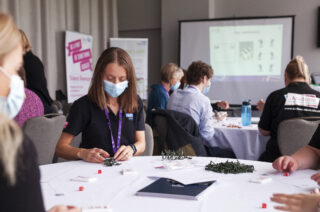Q Exchange
Joining Demand & Capacity with QI: Empowering the Front Line
- Proposal
- 2023

Meet the team
Also:
- Eloise Whittaker, Clinical Lead
- Emma Buck, Performance Team Manager
- Michael Rice, Operations Manager
- Vicky Shearer, Business Development Manager
- Matthew O'Reilly, NHS England Demand and Capacity Programme Manager
- Service Users (names tbc)
What is the challenge your project is going to address and how does it connect to the theme of 'How can improvement be used to reduce delays accessing health and care services'?
Lengthening waiting lists and the negative impact they are having on patient experience and outcomes are tough for clinical teams. For many, it feels like an impossible problem that will only get worse.
In 2022 we piloted, with some community services, an innovative training programme on understanding flow; demand & capacity data, concepts and modelling; and how to use QI to test change. The aim was to increase ability to understand and make improvements to waiting lists. Our evaluation demonstrated a positive impact: participating services report they feel able to make evidence based decisions on backlog clearance and workforce and have identified multiple opportunities for QI; ultimately, they feel more in control.
I found it really helpful to stop and think proactively. I know we have a lot of work to do but for the first time in a while I felt like there is light at the end of the tunnel..
What does your project aim to achieve?
The project will train and support front line teams, together with analysts, to understand their demand and capacity data, and develop simple demand and capacity models. The process commences with clinical pathway mapping which will enable staff to identify length of waits, issues of equality of access and bottlenecks. This will be dovetailed with QI training in, for example, the theory of constraints and experience based co-design. Support will be provided to apply these QI methods to make and test changes in practice. Teams will also work with service users to identify and co-design improvements in access to the service and help whilst they are waiting. Modelling outputs will enable planning for appropriate and safe staffing to clear or reduce waiting lists.
The beneficiaries are those waiting, the staff in clinical services and the broader healthcare system. Tangible benefits can be made, with transferable skills for ongoing improvements in service.
How will the project be delivered?
Where demand and capacity initiatives tend to be centralised, this model deliberately aims to upskill front line teams and facilitate shared learning.
We will take a cohort approach, supporting a number of teams at once with face-to-face training combined with ongoing facilitation. To enable implementation and spread, we would expect each team to include
- Operational manager
- Clinical representative(s)
- Administrative representative
- Analyst
- Service users
The project team has internal and external demand and capacity expertise, the lead for performance data/analysts, QI specialists, clinical representation, operation manager and business support manager.
Elements of the programme will include:
- Training in basic QI methods and tools, patient involvement and systems thinking
- Training in demand and capacity concepts and modelling principles
- Team support to understand data and develop models
- Team support to employ improvement methods
Impact will be measured via use of models, improvements in waiting times/access/ patient experience. Case studies will also be captured.
How is your project going to share learning?
This project will include an evaluation for impact and shared learning – both in terms of the process and the outcomes. We will produce guides and a toolkit to help people get started, which will be published on our website. These will include stories and case studies from teams involved, as well as staff and patients who are impacted.
We are working with the NHSE Demand and Capacity Team who will also include progress and outcomes on their webinar programme and selection of resources. They are particularly interested because this is taking place in a community trust. They would also like to learn more about how patients can be involved in demand and capacity modelling.
The evaluation and any resources will be available to any Q members, and we would like to share blogs and workshop content as the programme progresses.
How you can contribute
- Any ideas from anyone who has done something similar (particularly in a community context) would be very helpful.
Plan timeline
| 3 Jul 2023 | Programme start - Advertise for and recruit teams |
|---|---|
| 1 Sep 2023 | Pre-planning with teams; pre-training evaluation commences |
| 2 Oct 2023 | Training programme commences; PPI support for co-design |
| 1 Dec 2023 | Modelling and QI facilitation commences; post-training evaluation |
| 4 Mar 2024 | Co-design of tool kits and case studies etc for sharing |
| 28 Jun 2024 | Evaluation and toolkits published |
Comments
Emma Adams 23 Mar 2023
Really great idea. Often we expect our managers and teams to be able to 'magically' manage their demand without the skills and capabilities to do so. The resources you create will be really useful for sharing with others grappling with rising demands in community services.
Good luck!
Sarah Williams 27 Mar 2023
Thanks Emma … the pilot worked really well. It’s hard to make this sound attractive but that feeling of ownership and understanding is worth the investment of time. Hopefully see you soon
Comments are now closed for this post.